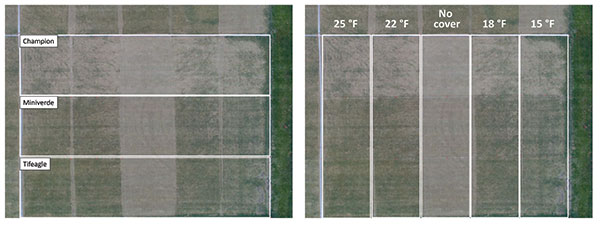How low can ultradwarf bermudagrasses go?
As ultradwarf bermudagrass (Cynodon dactylon x C. transvaalensis) use moves farther north, there is increased risk of winter injury from low temperatures and desiccation. The use of protective covers during winter is an expensive but obligatory practice for ultradwarf bermudagrass putting green survival. Currently, the USGA recommends covering ultradwarf bermudagrass at forecasted low temperatures of 25 degrees.
Research being conducted at the University of Arkansas is examining predicted low temperature thresholds for determining when to cover ultradwarf greens and examining effects on spring green-up from a late-fall wetting agent application.
This multiyear trial is being conducted on a green built to USGA guidelines planted with replicated plots of Champion, MiniVerde and Tifeagle ultradwarf bermudagrass. The protective covers are composed of permeable, black, woven polypropylene. Covers are deployed based on predicted low temperatures for Fayetteville, Ark. The predicted low temperatures used are 25, 22, 18 and 15 degrees, as well as an uncovered control. Once a cover is placed, it remains in place until forecasted temperatures exceed 45 degrees. During the green-up period winter injury is assessed using digital image analysis and visual ratings of percent green turfgrass coverage.
Two winters of data show that Champion is significantly less tolerant of cold temperatures than both Tifeagle and MiniVerde, resulting in more turf injury. The spring of 2015-16 showed hastened spring green-up in plots receiving a wetting agent application but results were not as conclusive for 2016-17.
Eric DeBoer, Mike Richardson, Ph.D., and Doug Karcher, Ph.D., University of Arkansas. Eric DeBoer can be reached at ejdeboer@uark.edu for more information.

(Left) Cultivar effect on spring green-up on March 21, 2017. (Right) Cover temperature effect on spring green-up on March 21, 2017.
Photos by: Eric DeBoer










